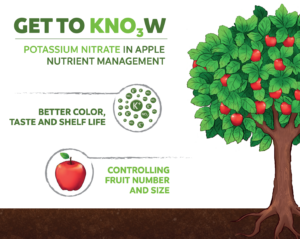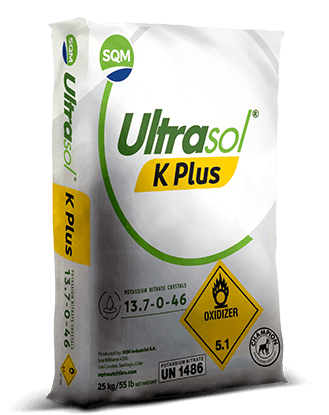The brix value is one of the most important fruit quality parameters for apple and pears, beside fruit skin color and fruit flesh firmness. Brix is a measure for the content of dissolved solids such as sugars and has a main impact on fruit taste. Foliar applications of potassium nitrate as Ultrasol® K Plus resulted in statistically significant higher brix values (+ 1 degree Brix), at harvest and after 3 months low-oxygen cold storage (ULO) of the fruits. Potassium nitrate was applied at 20 kg/ha during fruit development.
In apple, this amount was split over two applications of 10 kg/ha each, in pear three times 6,7 kg/ha was applied. Spray volume was controlled at 1000 L/ha.
The brix value is one of the most important fruit quality parameters for apple and pears, beside fruit skin color and fruit flesh firmness. Brix is a measure for the content of dissolved solids such as sugars and has a main impact on fruit taste. Foliar applications of potassium nitrate as Ultrasol® K Plus resulted in statistically significant higher brix values (+ 1 degree Brix), at harvest and after 3 months low-oxygen cold storage (ULO) of the fruits. Potassium nitrate was applied at 20 kg/ha during fruit development.
In apple, this amount was split over two applications of 10 kg/ha each, in pear three times 6,7 kg/ha was applied. Spray volume was controlled at 1000 L/ha.
German retail maintains 12° Brix as minimum requirement for regional fruit brands. Depending on year, variety, growing region (less solar radiation in the northern cultivation areas) and cultivation techniques (e. g. shading by hail nets) it is sometimes difficult to reach this level.

Figure 1. Fuji apple trees and Williams Christ pear trees just before harvest.
Katja Hora (Research Manager) - katja.hora@sqm.com:
Despite the importance of brix in pome fruits as a measure of quality for traders and retail, not much information on the increase of brix by application of potassium nitrate is available. An ongoing project, conducted by the university of applied sciences in Osnabrück, Germany provided the opportunity to test the effect of foliar applied potassium nitrate in a controlled experimental setting, under field conditions.
The beneficial effect of potassium nitrate applied by foliar spray on fruit sugar content is well known from other crops, e.g. citrus. Despite the generally adequate levels of potassium in the soil of these German orchards, it may not be available to the trees at the critical stage of fruit filling. Foliar applications with Ultrasol® K Plus could address this issue by increasing the level of potassium in the leaves and thus enhancing carbohydrate transport to the ripening fruits.
The trial was carried out in an experimental orchard of the Faculty of Agricultural Sciences and Landscape Architecture, under supervision of Prof. Dr. Diemo Daum. The trial was designed to assess individual fruit quality.
Total fruit yield was not considered since this was not the aim of the trial and would require more replications and larger treatment plots. The treatments were applied on individual trees (Figure 2), randomized over complete blocks, with 4 repeated blocks in pears, and 6 in apples. Prior to the first application, trees with a similar fruit load were selected.

Figure 2. After harvest 10 random fruits per tree were divided in parts, and an equal part of each fruit per tree was added to the blender in order to determine the average sugar content per repetition, expressed in degrees Brix.
Monthly foliar applications with Ultrasol® K Plus during fruit development and fruit ripening were compared with a control treatment (water treated at the same moments). For good coverage, a surfactant (BreakThru 0,02 %) was added to the spray solutions for both control and Ultrasol® K Plus. Table 1 gives the trial details. Potassium nitrate was applied at 20 kg/ha during fruit development. In apple, this amount was split over two applications of 10 kg/ha each, in pear three times 6,7 kg/ha was applied. Spray volume was controlled at 1000 L/ha.
After harvest, the fruits were assessed for fruit weight directly after harvest, and after 3 months of cold storage (Ultra Low Oxygen, 4ºC). At both moments also the % dry matter and degree brix were assessed (Figure 2).

Figure 3. Degrees brix in juice of Fuji apples and Williams Christ pears after harvest and after 3 months of ULO cold storage. Means with the same letter are not statistically different (Tukey p<0,05 for apple after harvest and all pear data or Games-Howell post-hoc test p<0,01 for apple after storage).
Results Highlights
The year 2018 offered exceptional hot and sunny weather conditions. Despite excellent brix values in all treatments, foliar applications with Ultrasol® K Plus realised a statistically significant difference in degree brix over the water-treated controls, in both apples and pears (Figure 3). No effect was seen on average fruit weight (average over all the treatments: 154 g/ pear fruit and 207 g/apple fruit), dry matter content, colour of the fruits (Figure 4) nor in weight-loss during storage (on average around 3% for both apples and pears).
Nevertheless, the possibility to increase the brix in pome fruits when the weather is less favourable, may meet with interest from fruit growers side. Even in fruit processing high brix levels in apples are preferred for apple purée production, e.g. for baby food. Furthermore, brix content is one of the criteria to determine optimal fruit harvest time: increasing brix with potassium nitrate foliar sprays can theoretically anticipate the harvest.
Table 1. Trial details for each crop

Figure 4. The fruits were also visually inspected for colouration. No obvious differences in colour of the fruits were observed. Left: Control, only surfactant, right: Ultrasol® K Plus (KNO3) + surfactant.
What is next?
Ideally, field trials in following years and different regions are necessary to confirm and clarify the positive effect of KNO3 on sugar content of pome fruits.





